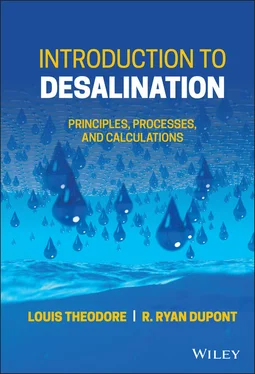Gray water – Domestic wastewater composed of water from kitchen sinks, bathroom sinks and tubs, clothes washers, and laundry tubs.
Greenhouse effect – The gradual rise in the average global temperature due to the absorption of infrared radiation reflected by the Earth’s surface by increasing amounts of carbon dioxide, methane, nitrous oxide, and other greenhouse gases in the air.
Groundwater – Water that exists underground in saturated zones beneath the land surface.
Groundwater basin – A porous formation with sides and bottom of relatively impervious material in which groundwater is held or retained.
Groundwater hydrology – The branch of hydrology dealing with groundwater sources, movement, recharge, depletion, etc.
Groundwater reservoir – An area below the ground surface in which groundwater is stored, also called an aquifer.
Groundwater recharge – The input of surface water to resupply groundwater reservoirs through infiltration at the soil surface or from the bottom of rivers and streams; the use of reclaimed wastewater, by surface spreading or direct injection, to replenish freshwater aquifers; to resupply freshwater aquifers to prevent saltwater intrusion, to control or prevent ground subsidence, and to augment non-potable or potable groundwater aquifers.
Groundwater system – A groundwater reservoir and its contained water; also, the collective hydrodynamic and geochemical processes at work in the reservoir.
Habitat – A dwelling place of a species or community, providing a particular set of environmental conditions (e.g. forest floor, seashore, etc.).
Hard water – Any water containing high levels of dissolved divalent cations, primarily calcium and magnesium, that interfere with some industrial processes and prevent soap from lathering.
Hardness (water) – A property of water causing formation of an insoluble residue when the water is used with soap and forming a scale in vessels in which water has been allowed to evaporate; it is due primarily to the presence of divalent ions of calcium and magnesium.
Heat exchanger – A unit or vessel in which a hot fluid stream transfers part of its energy to a cooler fluid stream.
Heat sink – A structure designed to absorb heat.
Heterogenous – A term used to describe a mixture of different phases (e.g. liquid–vapor, liquid–vapor–solid).
High dam – A dam that is taller than 165 feet; the first high dam was Hoover Dam in the United Sates; four other notable high dams are Grand Coulee Dam in the United States, Aswan High Dam in Egypt, Three Gorges Dam in China, and the Sardar Sarovar Dam in India.
Holding pond – A pond or reservoir, usually made of earth, that is built to store polluted runoff.
Holdup – A volume of material held or contained in a process vessel or line.
Homogenous – A term used to describe a mixture or solution comprised of two or more compounds or elements that are uniformly dispersed in each other.
Hot brine – A slightly salty subterranean water, the temperature of which is markedly higher than that dictated by the normal geothermal gradient; it can be employed as a source of geothermal energy.
Hot rock – A subterranean rock, the temperature of which is higher than would be dictated by the normal geothermal gradient; it can be employed as a source of geothermal energy.
Humidifier – A device for increasing the water content of air; it is usually incorporated into an air conditioning system.
Hydration – The chemical process of combination or union of water with other substances.
Hydraulic fill – An earth structure or grading operation in which the fill material is transported and deposited by means of water being pumped through a flexible or rigid pipe.
Hydrogeology – The geology of groundwater, with particular emphasis on the chemistry and movement of water.
Hydrologic cycle – The constant movement and cycling of water by evaporation, precipitation, and condensation in the Earth-atmosphere system.
Hydrology – The science dealing with the properties, distribution, and circulation of water in relation to the land surface.
Hydrolysis – The reaction of a salt with water to form an acid and a base.
Hydrophilic – A term used to describe a substance with an affinity for water.
Hydrophobic – A term used to describe a substance that separates from water or surfaces that repel water.
Hydrosphere – The part of the Earth that is composed of water, including oceans, seas, lakes, rivers, icecaps, etc.
Hydrothermal – A term used to describe any geological process involving heated or superheated water.
Ice – The allotropic, crystalline form of water.
Imported water – Water supply that is conveyed from one watershed to be used in another.
Impurity – The presence of one substance in another, often in such low concentration that it cannot be measured quantitatively by ordinary analytical methods.
In situ – A term used to describe any reaction occurring in place, and a term used to describe a fossil, mineral, or rock found in its original place of deposition, growth, or formation.
Induced draft – The negative pressure created by the action of a fan, blower, or other gas-moving device.
Industrial wastewater – The wastewater generated from industrial processes.
Industrial water – The water that is withdrawn from a source for sole use in an industrial process.
Infiltration – The penetration of water through the ground surface into sub-surface soil or the penetration of water from the soil into sewer, or other pipes through defective joints, connections, or other leaks in a system, or a land application technique where large volumes of wastewater are applied to land, allowed to penetrate the surface, and percolate through the underlying soil.
Inflow – An entry of extraneous stormwater into a sewer system from sources above the ground surface, typically through manhole covers or direct pumping, i.e. via sump pumps.
Influent – Any untreated wastewater stream flowing into a wastewater treatment plant or non-potable water entering a water treatment plant.
Injection well – A well into which fluids are injected for purposes such as waste disposal, remediation, hydraulic control, etc.
Injection zone – A geological formation, group of formations, or part of a formation receiving fluids through a well.
Inland waters – The waters of the United States in the inland zone, waters of the Great Lakes, and specified ports and harbors on inland rivers.
Inland zone – Land inside the coastal zone, excluding the Great Lakes and specified ports and harbors on inland rivers.
Insoluble – A term used to describe a substance that is incapable of being dissolved in a liquid.
Instantaneous sampling – The collecting of a sample in a very short period of time so that the sampling time is insignificant in comparison with the duration of the operation or the period being studied.
Instream use – The water use taking place within a stream channel, hydroelectric power generation, navigation, water quality improvement, fish propagation, or recreation.
Interstitial water – The water contained in the interstices of rocks, where the origin of the water is unknown or unspecified.
Ion exchange – A mass transfer process that involves the interchange of ions between a liquid and a solid material; it can be employed to concentrate and recover desired materials or to remove undesired ions from a water supply.
Irrigation – A technique for applying water or wastewater to land areas to supply the water and nutrient needs of plants.
Irrigation districts – Special units of local government that control the bulk of surface water supplies, primarily in the Western states in the United States.
Читать дальше












